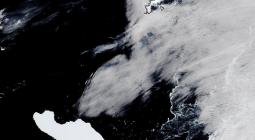Climate graphic of the week: huge ice loss risks Antarctica’s ‘destabilisation’
Melting season was more than a month longer than usual in parts of the continent
Antarctica is coming under intense pressure from climate change, with sea ice levels nearing a record low at the same time as a rapid melting of swaths of the continent’s ice mass.
The latest melting season in Antarctica, which takes place in the southern hemisphere summer during December, January and February, was more than a month longer in some areas of the continent, according to data from the National Snow and Ice Data Center and Liège university.
The Antarctic Peninsula in the north-west of continent has been particularly affected, with parts of the region experiencing 40 additional days of melting compared with the long-term average.
Antarctic sea ice extent also continues to be far below the long-term average for February, the month when sea ice is usually at its minimum levels, marginally beaten by the record low set during the same month last year. Xavier Fettweis, assistant professor of climatology at Liège university, said global warming now risked the “destabilisation of Antarctica”, whereby huge swaths of ice melted into the ocean and threaten rises in global sea levels of up to several metres by the end of this century. “If we have less sea ice, it is mainly because the ocean is warmer. And therefore we also see an increase in the mass lost below the ice sheet and the calving of icebergs,” he added.
Research published last month found that Antarctic sea ice extent fell to unprecedented lows at key periods across 2023. Sea temperatures have been exceptionally high across the world since last March, while surface air temperatures have remained far higher than normal in many areas of Antarctica, averaging 5C above the 1981-2010 average in some parts for the melting season. Fettweis said there had been an increase in precipitation levels in Antarctica this year, leading to higher snowfall and helping to increase the so-called surface mass balance — or difference between the precipitation that has accumulated on the upper surfaces of glaciers and ice sheets compared with the mass lost to melting, run-off and evaporation. But the rise in precipitation was not enough to offset the decline in total mass balance, which includes ice gains and losses from below the surface. Precipitation levels increase as global temperatures rise because the air can hold more moisture content.
“We have an increase of mass at the top of ice sheet due to heavy snowfall, but below the ice sheet and along the ice sheet margin we have an increase of melt due to warmer oceans, and therefore this increases the risk of the destabilisation of the ice sheet,” Fettweis said. A new study published on Thursday in the journal Nature also found that undersea anchors of ice, which hold in place the floating ice sheets that fortify Antarctica’s land ice, were shrinking at more than twice the rate observed 50 years ago. Researchers from Edinburgh university warned that further deterioration of these buttresses or pinning points, which help prevent Antarctica’s land ice from slipping into the ocean, would accelerate the continent’s contribution to rising sea levels. The findings — part of a study of changes in the thickness of Antarctic ice shelves, floating blocks of ice that are attached to land — found that only 15 per cent of pinning points reduced in size from 1973 to 1989, leading to localised pockets of thinning ice shelves. But the number of pinning points that shrank in size increased to 25 per cent from 1990 to 2000 and 37 per cent from 2000 to 2022. Ice sheets are found on 75 per cent of Antarctica’s coastline, covering an area equivalent to the size of Greenland, according to the researchers. Co-lead author Robert Bingham, professor of glaciology and geophysics at the School of GeoSciences at Edinburgh university, said: “What we are seeing around Antarctica is a sustained attack by climate warming to the buttresses that slow the conversion of ice melting. “This reinforces the need to take action where we can to reduce global carbon emissions.”
Cover photo: By Financial Times




